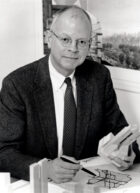“Can we pump barbecue smells through the terminal?” one gentleman asked. “You’ll know where you are as soon as you step off the plane.”
At each of the three dozen community meetings our team at SOM attended in Kansas City, we fielded a bevy of requests and all manner of ideas for the design of the region’s new one-million-square-foot terminal.
Many asked for more charging stations, better restrooms, or that it be centered on a fountain, just like the ones adorning the boulevards for which the city is known. Above all else, participants called for the terminal to be comfortable, convenient, and welcoming to all.
Though our firm has designed aviation projects in Seattle, Toronto, Mumbai, Dublin, and Bangalore, to name a few, Kansas City International Airport (KCI) was different. Voters approved the terminal’s construction by public referendum and the process called for multiple series of open meetings. This gave us the extraordinary opportunity to hear directly from the traveling public before we ever set pen to paper.
Beginning in 2017, our team fanned out across six city council districts and into neighboring Kansas. We met thousands of citizens in community centers, police stations, and churches. We quickly learned the depth of sentiment held by Kansas Citians for their airport, and what their aspirations were for the terminal.
As architects, planners and engineers, we see these buildings not only as civic structures, but as embodiments of a community’s character and values. When a traveller steps off a boarding bridge, the terminal is their first impression of their destination.
It is our responsibility to convey a sense of place through the terminal’s architecture. For the Kansas City region, this meant creating a certain Midwestern hospitality — a welcoming character that invites all people of all backgrounds and abilities into the terminal.
The mandate for inclusion we heard in those community meetings was strengthened when the mayor and city council issued a resolution calling for the terminal to be “the most accessible in the world.”


Though the challenge was lofty, we found a willing and capable partner in the Kansas City Aviation Department, whose leadership was committed to seeing these values realized in the construction.
In the 30 years since its enactment, the Americans with Disabilities Act (ADA) has revolutionized the built environment, eliminating physical obstacles that truly barred vast numbers of people from public space and therefore public life. At SOM, we’ve come to believe that the ADA, revolutionary in its time, is only a starting point.
Following the resolution for accessibility, we expanded our outreach. In addition to the general public, we met with advocacy groups, families of children with disabilities, and the local LGBTQ chamber of commerce — groups who gave us valuable insights into how we might prioritize access.
Inclusivity through intelligent planning
The key to accessible terminal design is a rigorous approach to planning the building’s layout. Intuitive, navigable buildings benefit all users, irrespective of their abilities.
The design process began with a thorough analysis of the flight schedule as well as the proposed program — the list of rooms and facilities needed to make the terminal function. Working with the aviation department and airlines, we right-sized the terminal. Efficiencies in planning enabled us to lower construction costs, shorten walking distances, and improve the passenger experience.
For passengers with reduced mobility, wheelchair users, and even families with small children, level changes can pose a daunting challenge to travel. In Kansas City, instead of building a bridge or a below-grade tunnel, the team created an above-grade passage that connects the building’s two concourses.

This “connector” remains level with check-in and security. Glass walls on both sides offer sweeping views of the airfield. This arrangement eliminates the need for escalators and gives passengers a consistent visual reference for their position in the journey from gate to baggage claim.
Beyond the requirements
Though the ADA acted as guide, the project team found every opportunity to exceed the requirements on items big and small. We included more service animal relief areas, more (and wider) curb cuts for wheelchair van access, and larger fonts on signage.
Rather than interspersing a few wheelchair-accessible counters throughout the building, every gate desk, check-in position, and info desk is set to an ADA-accessible height.
Restrooms can be the most difficult part of air travel for many passengers. In Kansas City’s new terminal, every stall exceeds the required dimensions. Their doors open outward to allow passengers to bring bags inside. Every restroom block has a dedicated nursing room, a family restroom, and a room for changing clothes, with a bench and full-length mirror.

Parents of adult children with disabilities requested changing tables that could accommodate them; two of the family restrooms contain motorized, adjustable tables for that purpose.
The spirit of inclusion extends beyond ability to identity. Two large restrooms of 24 and 28 stalls are designated as all-gender. These restrooms will contain floor to ceiling partitions for privacy and grouped sinks. While much of the conversation surrounding all-gender restrooms has focused on the trans community, we’ve seen great benefits for all users.
At KCI, passengers will no longer encounter long lines for the women’s room while stalls sit empty in the men’s room. Parents traveling with children too young to use the restroom alone, and too old to feel comfortable in a restroom designated for the opposite gender, will no longer have to make a choice. Bench seating with a view to the stall doors lets them keep watch over their charges.
Amenities for all passengers
The experience of flying can be stressful, taxing, and uncomfortable. For children on the autism spectrum or with sensory processing disorders, the activity and unfamiliarity of the airport can be excruciating.
In our experience across building types (not only airports), we’ve increasingly seen the inclusion of sensory rooms into building programs. These spaces provide a quiet respite from the activity of the terminal, with soothing lighting, sound-dampening materials, and engaging play areas. At KCI, the sensory room will be divided into a series of more intimate play spaces, giving a sense of privacy to children and their families as they prepare to board or rest after a long journey.

For passengers with dementia, air travel can be similarly disorienting. Working closely with a local dementia advocacy group, we adapted the design of a Quiet Room — a program commonly called a non-denominational chapel — into a space that might accommodate prayer and meditation or give persons with dementia a place to prepare for the journey.
In dialogue with those groups, we found that simple adjustments, such as providing moveable seating for traveling companions, might make the difference in creating a comfortable passenger experience.
The terminal’s Airplane Simulation Room will give passengers who are unfamiliar or uncomfortable with air travel the chance for a “test run” in the days before a trip. After making an appointment with airport staff, visitors will be ushered through security and into a room that simulates the look, lighting, and feeling of boarding an aircraft.
Situated through a corridor designed to look like a jet bridge, the simulation room contains the real components of a Boeing 757, including a bulkhead, seats, and even a (non-functional) lavatory.
Access to the terminal, access to the world
Air travel opens the world to passengers — giving them the chance to hold a new grandchild in a distant city, to see works of art they’ve only known from books, or to explore winding alleys in ancient cities.
These journeys begin and end in the buildings we design. If those terminals are not accessible and inclusive, we close the possibility of these experiences to vast segments of the public.
In the design of the Kansas City International Airport’s New Terminal, due to open in March 2023, we’ve seen the remarkable benefits to be gained by working closely with local communities to develop a building that welcomes all.

Jordan Pierce is an Associate Principal at SOM. Based in San Francisco and previously in New York, he has contributed to airport and transportation projects including Kansas City International Airport, Kempegowda International Airport in Bengaluru, and Terminal 2 at Chhatrapati Shivaji International Airport in Mumbai.
This article was first published in Airport World.




